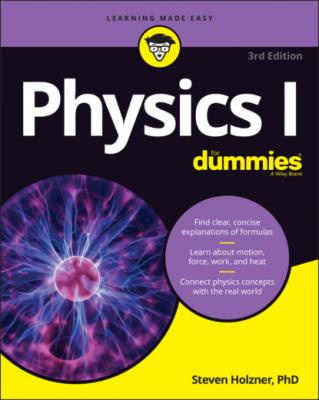Physics I For Dummies. Steven Holzner
Читать онлайн.| Название | Physics I For Dummies |
|---|---|
| Автор произведения | Steven Holzner |
| Жанр | Физика |
| Серия | |
| Издательство | Физика |
| Год выпуска | 0 |
| isbn | 9781119872245 |
Taking off: Putting the acceleration formula into practice
Here’s an acceleration example. As they strap you into the jet on the aircraft carrier deck, the mechanic says you need to take off at a speed of at least 62.0 m/s. You’ll be catapulted at an acceleration of 31 m/s2. Is there going to be enough catapult to do the job? You ask how long the catapult is. “A hundred meters,” says the mechanic, finishing strapping you in.
Hmm, you think. Will an acceleration of 31 m/s2 over a distance of 100 meters do the trick? You take out your clipboard and ask yourself: How far must I be accelerated at 31 m/s2 to achieve a speed of 62 m/s?
First think of the distance that you need to be accelerated over as the size of the displacement from your initial position. To find this displacement, you can use the equation
Solving for
Plugging in the numbers and solving gives you the change in time:
Okay, so it takes 2.0 seconds for you to reach a speed of 62 m/s if your rate of acceleration is 31 m/s2. Now you can use this equation to find the total distance you need to travel to get up to this speed; it is the size of the displacement, which is given by
Plugging in the numbers gives you
So it will take 62 meters of 31 m/s2 acceleration to get you to takeoff speed — and the catapult is 100 meters long. No problem.
Understanding uniform and nonuniform acceleration
Acceleration can be uniform or nonuniform. Nonuniform acceleration requires a change in acceleration. For example, when you’re driving, you encounter stop signs or stop lights often, and when you slow to a stop and then speed up again, you take part in nonuniform acceleration.
Other accelerations are very uniform (in other words, unchanging), such as the acceleration due to gravity near the surface of the Earth. This acceleration is 9.8 meters per second2 downward, toward the center of the Earth, and it doesn’t change (if it did, plenty of people would be pretty startled).
Relating Acceleration, Time, and Displacement
This chapter deals with four quantities of motion: acceleration, velocity, time, and displacement. You work the standard equation relating displacement and time to get velocity:
And you see the standard equation relating velocity and time to get acceleration:
But both of these equations only go one level deep, relating velocity to displacement and time and acceleration to velocity and time. What if you want to relate acceleration to displacement and time? This section shows you how you can cut velocity out of the equation.
Not-so-distant relations: Deriving the formula
You relate acceleration, displacement, and time by messing around with the equations until you get what you want. First, note that displacement equals average velocity multiplied by time:
You have a starting point. But what’s the average velocity? If your acceleration is constant, your velocity increases in a straight line from 0 to its final value, as Figure 3-4 shows.
FIGURE 3-4: Increasing velocity under constant acceleration.
The average velocity is half the final velocity, and you know this because there’s constant acceleration. Your final velocity is
